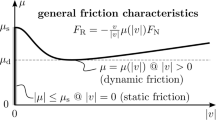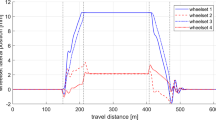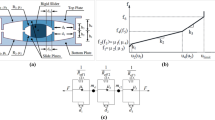Abstract
The aim of this paper is to discuss the effect of cosimulation on a railway vehicle/track/soil model. Firstly, only the vehicle and a flexible track are considered without taking the soil flexibility into account. Two well-known co-simulation approaches are used: a parallel approach, called Jacobi, and a sequential approach, called Gauß–Seidel. The definition of the subsystems, thus the place at which the entire system is split, is discussed. For the vehicle/track case, the split can be performed either between the wheel and the rail or between the rail and the sleepers. Moreover, it is shown that the output of each subsystem, either a kinematic quantity or a force, has a significant impact on the results since. It is indeed observed that, for the vehicle/track model, exchanging only kinematic quantities between the subsystem is less accurate but more stable than exchanging forces and kinematic quantities. The macrotimestep influence is also investigated and it is demonstrated that when the macrotimestep decreases, all co-simulation configuration converge to the same solution. Secondly, the soil flexibility and the vehicle influences are considered with a vehicle/track/soil model involving two different software environments: a multibody dedicated program for the vehicle and the track and a finite element analysis program for the soil. Generally, a deterioration of the results is observed in soft soil cases.














Similar content being viewed by others
References
Thompson, D.J., Kouroussis, G., Ntotsios, E.: Modelling, simulation and evaluation of ground vibration caused by rail vehicles. Veh. Syst. Dyn. 57(7), 936–983 (2019)
Yang, J., Zhu, S., Zhai, W., Kouroussis, G., Wang, Y., Wang, K., Lan, K., Xu, F.: Prediction and mitigation of train-induced vibrations of large-scale building constructed on subway tunnel. Sci. Total Environ. 668, 485–499 (2019)
Kouroussis, G., Verlinden, O., Conti, C.: On the interest of integrating vehicle dynamics for the ground propagation of vibrations: the case of urban railway traffic. Veh. Syst. Dyn. 48(12), 1553–1571 (2010)
Alves Costa, P., Calçada, R., Silva Cardoso, A.: Vibrations induced by railway traffic: influence of the mechanical properties of the train on the dynamic excitation mechanism. In: De Roeck, G., Degrande, G., Lombaert, G., Müller, G. (eds.) 8th International Conference on Structural Dynamics: EURODYN 2011, Leuven (Belgium), pp. 804–811 (2011)
Zhai, W., Sun, X.: A detailed model for investigating vertical interaction between railway vehicle and track. Veh. Syst. Dyn. 23(supplement), 603–615 (1994)
Zhai, W.M., True, H.: Vehicle-track dynamics on a ramp and on the bridge: simulation and measurements. Veh. Syst. Dyn. 33(supplement), 604–615 (1999)
Kece, E., Reikalas, V., DeBold, R., Ho, C.L., Forde, M.C.: Evaluating ground vibrations induced by high-speed trains. Transp. Geotech. 20, 100236 (2019)
Galvín, P., Domínguez, J.: Experimental and numerical analyses of vibrations induced by high-speed trains on the Córdoba–Málaga line. Soil Dyn. Earthq. Eng. 29, 641–657 (2009)
Kouroussis, G.: Predicting High-Speed Railway Vibration Using Time-Domain Numerical Engineering Approaches pp. 187–216. ICE Publishing (2019)
Olivier, B., Connolly, D.P., Alves Costa, P., Kouroussis, G.: The effect of embankment on high speed rail ground vibrations. Int. J. Rail Transp. 4(4), 229–246 (2016)
Antunes, P., Magalhães, H., Ambrósio, J., Pombo, J., Costa, J.: A co-simulation approach to the wheel–rail contact with flexible railway track. Multibody Syst. Dyn. 45(2), 245–272 (2019)
Wu, Q., Spiryagin, M., Cole, C., McSweeney, T.: Parallel computing in railway research. Int. J. Rail Transp. 8(2), 111–134 (2020). https://doi.org/10.1080/23248378.2018.1553115
Wu, Q., Sun, Y., Spiryagin, M., Cole, C.: Parallel co-simulation method for railway vehicle–track dynamics. J. Comput. Nonlinear Dyn. 13(4), 041004 (2018)
Dietz, S., Hippmann, G., Schupp, G.: Interaction of vehicles and flexible tracks by co-simulation of multibody vehicle systems and finite element track models. Veh. Syst. Dyn. 37(sup1), 372–384 (2002)
Olivier, B., Verlinden, O., Kouroussis, G.: A vehicle/track co-simulation model using easydyn. In: 7th International Conference on Computational Methods in Structural Dynamics and Earthquake Engineering, Hersonissos, Greece, pp. 1–10 (2019)
Verlinden, O., Fékih, L.B., Kouroussis, G.: Symbolic generation of the kinematics of multibody systems in EasyDyn: from MuPAD to Xcas/Giac. Theor. Appl. Mech. Lett. 3(1), 013012 (2013)
Kouroussis, G., Verlinden, O., Conti, C.: Influence of some vehicle and track parameters on the environmental vibrations induced by railway traffic. Veh. Syst. Dyn. 50(4), 619–639 (2012)
Nielsen, J.C.O., Abrahamsson, T.J.S.: Coupling of physical and modal components for analysis of moving non-linear dynamic systems on general beam structures. Int. J. Numer. Methods Eng. 33(9), 1843–1859 (1992)
Kouroussis, G., Van Parys, L., Conti, C., Verlinden, O.: Using three-dimensional finite element analysis in time domain to model railway-induced ground vibrations. Adv. Eng. Softw. 70, 63–76 (2014)
Olivier, B., Verlinden, O., Kouroussis, G.: A vehicle/track/soil model using co-simulation between multibody dynamics and finite element analysis. Int. J. Rail Transp. 8(2), 135–158 (2020)
Busch, M.: Zur effizienten Kopplung von Simulationsprogrammen. Ph.D. thesis, Kassel University (2012)
Gomes, C., Thule, C., Broman, D., Larsen, P., Vangheluwe, H.: Co-simulation: a survey. ACM Comput. Surv. 51(3), 49 (2018)
Busch, M.: Continuous approximation techniques for co-simulation methods: analysis of numerical stability and local error. Z. Angew. Math. Mech. 96(9), 1061–1081 (2016)
Olivier, B., Verlinden, O., Kouroussis, G.: In: Schweizer, B. (ed.) Stability and Error Analysis of Applied-Force Co-Simulation Methods Using Mixed One-Step Integration Schemes. IUTAM Bookseries, vol. 35, pp. 243–254. Springer, Berlin (2019). Chapter 12
Author information
Authors and Affiliations
Corresponding author
Additional information
Publisher’s Note
Springer Nature remains neutral with regard to jurisdictional claims in published maps and institutional affiliations.
Rights and permissions
About this article
Cite this article
Olivier, B., Verlinden, O. & Kouroussis, G. Effect of applied force cosimulation schemes on recoupled vehicle/track problems. Multibody Syst Dyn 50, 337–353 (2020). https://doi.org/10.1007/s11044-020-09748-8
Received:
Accepted:
Published:
Issue Date:
DOI: https://doi.org/10.1007/s11044-020-09748-8




